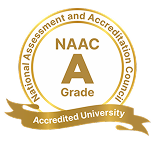Academic Calendar-B. Pharm. & M. Pharm. 2024-2025 Click here B.PHARM. MANAGEMENT QUOTA/ NRI SPONSORED SEATS ADMISSIONS YEAR: 2025-2026 Click here B.PHARM. VACANT QUOTA SEATS ADMISSIONS YEAR: 2025-2026 Click here M.Pharm. Vacant Quota Seats Admission 2025-26 Click here

Academic Calendar-B. Pharm. & M. Pharm. 2024-2025 Click here B.PHARM. MANAGEMENT QUOTA/ NRI SPONSORED SEATS ADMISSIONS YEAR: 2025-2026 Click here B.PHARM. VACANT QUOTA SEATS ADMISSIONS YEAR: 2025-2026 Click here M.Pharm. Vacant Quota Seats Admission 2025-26 Click here

You may interested in
- Brief Report on Hands on Workshop On “Docking” Organized by- Ganpat university, SHREE S K PATEL COLLEGE OF PHARMACEUTICAL EDUCATION AND RESEARCH and MEHSANA URBAN INSTITUTE OF SCIENCES collab
- One Day Workshop on “Quality Benchmarks in Higher Education: Accreditation & Ranking Insights” Organized by IQAC Cell - Ganpat University & Faculty of Pharmacy – Ganpat University 13th Septem
- Seminar on “Prototype Validation: Converting Ideas into Start-ups”
- GANPAT UNIVERSITY – FACULTY OF PHARMACY organizes GUEST LECTURE ON “ANALYTICAL METHOD VALIDATION: STANDARDS, STRATEGIES AND SUCCESS” Monday, 5 th May, 2025
- GANPAT UNIVERSITY SHREE S. K. PATEL COLLEGE OF PHARMACEUTICAL EDUCATION & RESEARCH Report on HPTLC Hands on Training Participation
- WEBINAR SUMMARY REPORT Title of the program: “Menstrual Health and Hygiene Management” Date: 19/02/2024 Venue: Seminar Hall, Faculty of Pharmacy Coordinator: Dr. Geeta Patel, Members: Dr. Bho
- REPORT of Five Days Workshop on “Skill Enhancement for Dosage Form Development” (10th to 14th July 2023)
- GANPAT UNIVERSITY SHREE S. K. PATEL COLLEGE OF PHARMACEUTICAL EDUCATION AND RESEARCH A REPORT ON VISIT At Atal Incubation Centre, L. M. College of Pharmacy, Ahmedabad On 30th March 2024
- ATISHRESHTH - 365 inspiring lecture series by 365 Distinguished Alumni organized by Ganpat University for the year 2023
- GANPAT UNIVERSITY – FACULTY OF PHARMACY & SPINCO BIOTECH PVT. LTD. organizes One Day Hands on Workshop “Fundamentals and Applications: HPLC” 26th February, 2024
- GANPAT UNIVERSITY – FACULTY OF PHARMACY & SPINCO BIOTECH PVT. LTD. organizes One Day Workshop on “Fundamentals of Liquid Chromatography (HPLC)” 14th July, 2023
- REPORT of International Conference on Pharmacy, Food, Agriculture, Science and Technology on “Innovations for Growth and Sustainability” (22nd & 23rd December 2023)
- Report on Entrepreneurship Awareness Seminar 2024 Student Startups and Incubation Centre, Ganpat University sponsored One-day seminar on “Entrepreneurship Awareness” 28h February, 2024
- Report on Entrepreneurship Awareness Seminar Student Startups and Incubation Centre, Ganpat University sponsored One-day seminar on “Entrepreneurship Awareness” 12th September, 2024
- Report on Entrepreneurship Awareness Seminar 2023 Student Startups and Incubation Centre, Ganpat University sponsored One-day seminar on “Entrepreneurship Awareness” 17th February, 2023
- GSBTM & DST SPONSORED TWO DAYS NATIONAL WORKSHOP ON “ANALYTICAL TECHNIQUES: SPECTROSCOPY & CHROMATOGRAPHY”
Past Events
-
GANPAT UNIVERSITY – FACUL...
GANPAT UNIVERSITY – FACULTY OF PHARMACY & SPINCO BIOTECH PV...
-
Industry Academia Meet 20...
Ganpat University Centre for Advanced Research Studies (CARS) Sponsored
-
Webinar on “ Knowledge f...
On the auspicious occasion of Vasant Panchami, Shri SK Patel College of Pharmace...
-
Webinar on “Multi-tasking...
Webinar on “Multi-tasking QSAR approach” organized by SKPCPER,
-
Organized a Series of Web...
Target Audience: Science students Date of Workshop , Total number of particip...
-
One Day National Workshop...
The inauguration function of this program was organized at Seminar Hall, MBA Bui...
-
Webinar on “Tele-Counseli...
16/05/2021 8.30 PM to 11.45 PM Dr. Giribala Patel MD, Oncologis...
-
GPSC Sponsered Two Days R...
GPSC Sponsered Two Days Refresher Course
-
GANPAT UNIVERSITY – FACUL...
GANPAT UNIVERSITY – FACULTY OF PHARMACY organizes GUEST L...
-
REPORT of Five Days Works...
REPORT of Five Days Workshop on “Skill Enhancement for Dosage Form D...
-
GANPAT UNIVERSITY SHREE S...
GANPAT UNIVERSITY SHREE S. K. PATEL COLLEGE OF PHARMACEUTICAL EDUCATION AN...
-
Report on Entrepreneurshi...
Report on Entrepreneurship Awareness Seminar 2024 Student Startups and Inc...
-
Report on Entrepreneurshi...
1 Report on Entrepreneurship Awareness Seminar Student Startups and...
-
Report on Entrepreneurshi...
Report on Entrepreneurship Awareness Seminar 2023 Student Startups and Inc...
-
GSBTM & DST SPONSORED TWO...
GSBTM & DST SPONSORED TWO DAYS NATIONAL WORKSHOP ON “ANALYTICAL TECHNI...
-
Report on Training Progra...
Report on Training Program for Non-Teaching Staff Members at V B Tech Auto...
-
"INNOVATIONS IN HERBAL CO...
The inauguration function of this program was organized on 26th August, 2021. In...
-
Smart Referencing Using M...
It was webinar cum training session of Mendeley software for reference managemen...
-
Role of Pharmacist in Eme...
A webinar was organized on The Role of pharmacist in emerging pharmaceutical ind...
-
SPER 10th Annual Internat...
Chief Guest, Dr. N.K. Ganguly, Former Director General, ICMR talked about the cu...
-
GUJCOST Sponsored two day...
Inauguration function on 7th August 2021 via was started with Maa Saraswati Vand...
-
Research Orientation Prog...
Total Participants 116 Program was started with welcome of guests and deep...
-
ONE DAY WORKSHOP ON RECEN...
ONE DAY WORKSHOP ON RECENT TRENDS OF LIQUID CHROMATOGRAPHY(HPLC)
-
Online Mock Test for B.Ph...
We had conducted National GPAT Mock Test (Online) for B.Pharm Semester VI and VI...
-
Two Days National Worksho...
INSA and GUJCOST, DST sponsored Two Days National Workshop on “Patenting i...
-
Integrating Ayurveda & He...
Integrating Ayurveda & Herbal Drugs for Next Generation Therapeutics & S...
-
GSPC Sponsered Two Days R...
GSPC Sponsered Two Days Refresher Course
-
Role of Qbd-DoE in Pharma...
Role of Qbd-DoE in Pharmaceutical Product Development
-
Two Days Workshop on " HA...
Two Days Workshop on " HANDS ON TRAINING ON ANALYTICAL TECHNIQUES: SPECTROS...
-
National Seminar on Curre...
National Seminar on Current Trends in Drug Delivery of Phytoconstituents
-
National Seminar on Analy...
National Seminar on Analytical Spectroscopy: Recent Trends and Its Advancements
-
Webinar on Patents and In...
Webinar on Patents and Intellectual Property Rights
-
One Day National Workshop...
One Day National Workshop on Assessment of Research in View of Patentability&nbs...
-
Faculty Development Progr...
Faculty Development Program on Recent Advances in novel drug delivery syste...
SHREE S. K. PATEL COLLEGE OF PHARMACEUTICAL EDUCATION & RESEARCH GANPAT UNIVERSITY INDUSTRIAL VISIT TO SPENSUS PHARMACEUTICALS LTD

Description
SHREE S. K. PATEL COLLEGE OF PHARMACEUTICAL EDUCATION & RESEARCH
GANPAT UNIVERSITY
INDUSTRIAL VISIT TO SPENSUS PHARMACEUTICALS LTD
Subject: Industrial Visit to Spensus Pharmaceuticals Ltd, Mehsana
Participants: Faculty (04) & M Pharm PQA students (15)
Date: 11/04/2025
Department of Pharmaceutical Quality Assurance, Shree S. K. Patel College of Pharmaceutical Education & Research, Ganpat University planned an Industrial Visit to Spensus Pharmaceuticals Ltd., Mehsana for M. Pharm. Pharmaceutical Quality Assurance students on 11th April, 2025. Total 04 faculty members and 15 M. Pharm students were visited the company. The visit was organized to bridge the gap between theoretical knowledge and real-world practices in the pharmaceutical sector.
Objective of the Visit
- The primary objectives of the visit were:
- To understand the functioning of a pharmaceutical manufacturing unit.
- To learn about various departments and their roles in drug development.
- To observe and analyze the production processes, quality control, and packaging techniques.
- To gain insight into the regulatory and safety standards followed in the industry.
The visit was started with the welcome of faculty members and students by the team of Spensus including Mr. Harshad Patel, Plant Head., Mr. Dilip Prajapati, QA Head., Mr. Sushil Patel, QC Head and Dr. Nilesh Patel, Director, Spensus Pharma. Ltd. The team explained the basic overview of the company with different department and operations.
Production Department Visit
The entry door for raw materials and man is different to avoid contamination, there are reverse laminar air flow and there are different exit doors for materials. All the raw materials were stored there, checked, weighed on weighing machine and sampling was done there. They have different room for the materials to be stored at cool conditions, the area was neat, hygienic and clean. There is a fridge which stored material at 2 to 8 degree Celsius and a refrigerator which stores raw materials below -25 degree Celsius. Vacuum cleaning of material is also done there. Mr. Dilip Prajapati, QA Head have explained all the labelling and storage conditions of the raw material in detail. There are 3 different types of labels used for raw material. White label for quarantine material, yellow for under test and green for approved material. Hygrometer is used to maintain temperature and humidity.
The dispensing room is where the flow of materials from the warehouse occurs, including excipients, raw materials, solvents, and color materials. In the production department, there is a planned layout at the entrance of the company, where QA Head has introduced students to the materials that come from the dispensing room through a dynamic pass box. The production area also contains a tools room and a quarantine room for in-process materials.
Tablet manufacturing involves using a tablet press machine, alongside an auto coater for tablet coating. There is a visual inspection room designated for coated tablets, as well as a quarantine area for finished products. Different packaging methods are utilized depending on the product, such as a pouch packing machine that utilizes fin seal packaging, and a precision balance is used to ensure the correct weight of each package. Finally, there is a finished store for completed products. Overall, the production area in a pharmaceutical facility is designed as a GMP-compliant, segregated space where various unit operations involved in tablet manufacturing are carried out.
QC/QA Department Visit
Mr. Sushil Patel has introduced students to the Quality Control (QC) area, where products and raw materials are tested using HPLC, UV-spectrophotometry, and infrared spectroscopy. Students learn the working principles and procedures for analyzing products and checking solvent limits, with all instruments calibrated every six months. The QC area includes equipment for dissolution testing, pH measurement, and friability testing, as well as a physicochemical room with essential equipment like hot air ovens and water baths. Additionally, there are designated stability rooms for long-term (25°C/60% RH), accelerated (40°C/75% RH), and intermediate (30°C/65% RH) stability testing, equipped with walk-in stability chambers, data loggers, and alarms for monitoring deviations. Documentation includes stability protocols, reports, and chamber qualification records.
The visit was concluded with thanks to Dilip Prajapati, QA Head; Sushil Patel, QC Head; Harshad Patel, Plant Head; and Nilesh Patel, Director of Spensus Pharma, for their invaluable contributions during the overall visit.
This experience has been invaluable as it gave us insight into how industries operate and helped us identify the connections between our academic knowledge and practical applications as Pharmaceutical Quality Assurance faculty and students. We gained a better understanding of how documentation is performed in accordance with regulatory guidelines.






